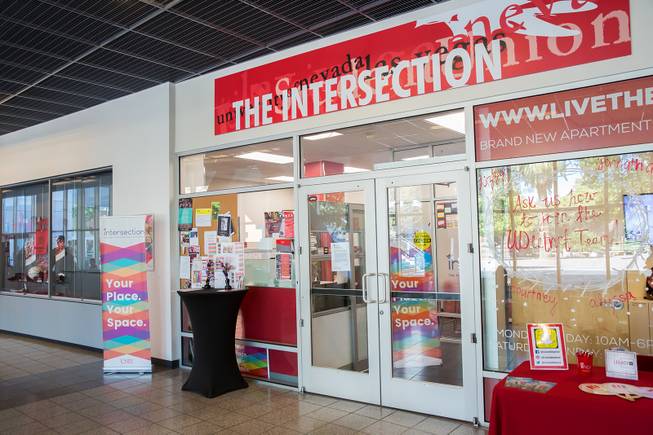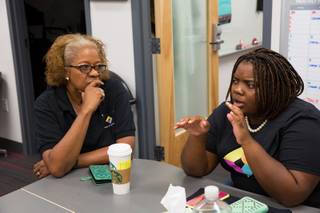
UNLV Intersection, the Academic Multicultural Resource Center at UNLV, located inside the Student Union, Friday Sept. 21, 2018.
Sunday, Sept. 23, 2018 | 2 a.m.
UNLV is ranked as the most diverse university for undergraduates on the U.S. News & World Report’s annual listing for the Best Ethnic Diversity category.
With that ranking now comes the resources to help those students excel. The Intersection, UNLV’s Academic Multicultural Center, serves these diverse students, most of whom are the first-generation to attend college.
“The idea is to create a visible multicultural resource center at a diverse institution to remove perceived barriers and stigma wherever we identify as you know diverse individuals attending college,” said Patrick Naranjo, the resource coordinator for the Intersection.
Those barriers include students who need food, emergency financial assistance, mentoring, or job application training — all services provided by the Intersection.
The center opened in April 2017 on the first floor of UNLV’s student union to help the nontraditional student body thrive by providing a one-stop resource center where students can have access to support.
“Everyone that I talked to—whether it was faculty, whether it was students, whether it was outside community—people are all indicated that a space was needed to assist first-generation students and students of color here at UNLV to help them navigate the university,” said Harriet Barlow, the Intersection’s executive director.
UNLV reports that 31 percent of its undergraduates are the first generation to attend college, with 57 percent of undergraduates reporting being a part of a racial or ethnic minority
The organization’s name is in reference to the term “intersectionality,” which refers to the cumulative way that different forms of discrimination, like race, class or gender, combine to impact the experiences of marginalized groups or people.
The term was coined by law professor Kimberlé Crenshaw in 1980s. Crenshaw visited the UNLV group last April to celebrate the one-year anniversary of the program, Barlow said.
Charmaine Wilcox, who is studying political science and biology, said it was difficult to find a mentor in the sciences who looked like her and could relate to her story.
“We’re all complex individuals, not just because we’re first-generation, not just because we’re people of color, but we all have our own stories like I am a single mother,” Wilcox said. “So, coming to the intersection means that I’m able to talk to someone who understands what it means to be a mother, understands what it means to be a woman of color, understand what it means to try and succeed.”
The Intersection helps connect students like Wilcox to mentors and guides so that they can thrive.
“That’s where we stand as being a resource and a hub connecting students to faculty, staff department on and off campus to help them be successful,” Barlow said.
They also help with emergency financial assistance.
CSUN, the undergraduate student government, allotted the group monies for the Intersection Cares Emergency Fund to assist students with an unforeseen financial emergency which could prevent them from continuing their education. The funds don’t have to be repaid but aren’t intended to replace financial aid or be used for routine expenses.
Barlow said the group helps students feel comfortable seeking guidance and resources, saying each student is more than just the label attached to them.
“What we represent is a new application on behalf of a post-secondary institution to better connect diverse students, right. We got international students, we got Native students, DACA students, all these wonderful individuals that make us different, daring place,” Naranjo said.

